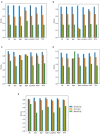Machine learning in the loop for tuberculosis diagnosis support
- PMID: 35958865
- PMCID: PMC9362992
- DOI: 10.3389/fpubh.2022.876949
Machine learning in the loop for tuberculosis diagnosis support
Abstract
The use of machine learning (ML) for diagnosis support has advanced in the field of health. In the present paper, the results of studying ML techniques in a tuberculosis diagnosis loop in a scenario of limited resources are presented. Data are analyzed using a tuberculosis (TB) therapy program at a health institution in a main city of a developing country using five ML models. Logistic regression, classification trees, random forest, support vector machines, and artificial neural networks are trained under physician supervision following physicians' typical daily work. The models are trained on seven main variables collected when patients arrive at the facility. Additionally, the variables applied to train the models are analyzed, and the models' advantages and limitations are discussed in the context of the automated ML techniques. The results show that artificial neural networks obtain the best results in terms of accuracy, sensitivity, and area under the receiver operating curve. These results represent an improvement over smear microscopy, which is commonly used techniques to detect TB for special cases. Findings demonstrate that ML in the TB diagnosis loop can be reinforced with available data to serve as an alternative diagnosis tool based on data processing in places where the health infrastructure is limited.
Keywords: diagnosis support systems; machine learning; machine learning in the loop; relevance analysis; tuberculosis diagnosis.
Copyright © 2022 Orjuela-Cañón, Jutinico, Awad, Vergara and Palencia.
Conflict of interest statement
The authors declare that the research was conducted in the absence of any commercial or financial relationships that could be construed as a potential conflict of interest.
Figures


References
-
- Witten IH, Frank E, Hall MA, Pal CJ. Data Mining: Practical Machine Learning Tools and Techniques. New York, NY, USA: Morgan Kaufmann; (2016).
-
- Annabel B, Anna D, Hannah M. Global Tuberculosis Report 2019. Geneva: World Heal Organ; (2019).
Publication types
MeSH terms
LinkOut - more resources
Full Text Sources
Medical

